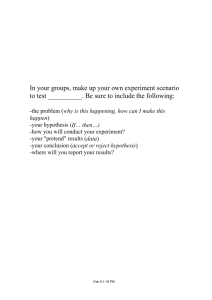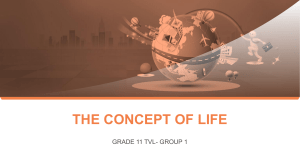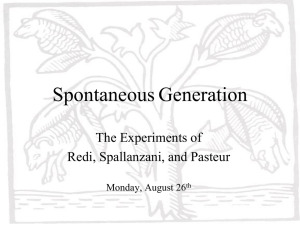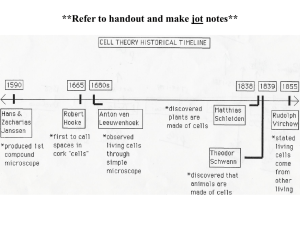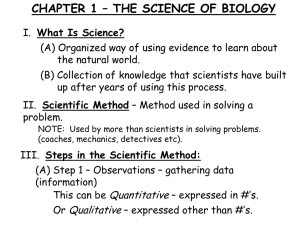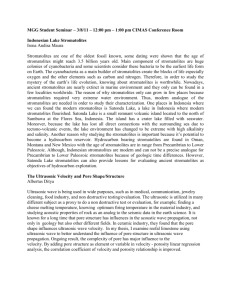Origins of Life PowerPoint
advertisement
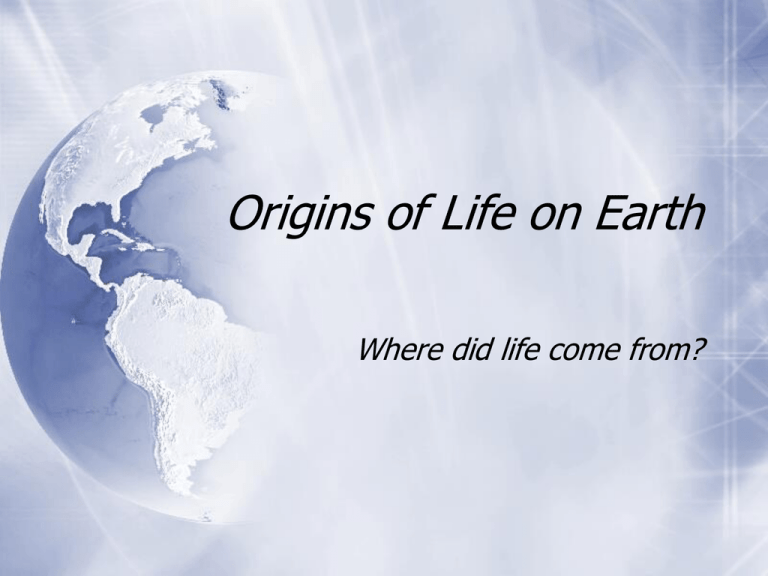
Origins of Life on Earth Where did life come from? Early Ideas Spontaneous Generation Believed life “arose” from nonliving objects. Mice came from piles of grain Bees were produced from carcasses of cattle Maggots came from rotting meat Lice from sweat Francesco Redi 1668 Hypothesized maggots arose from eggs that were to small to see with the naked eye. Tested his hypothesis by placing meat in several jars. ½ open to air directly ½ covered with gauze Gauze covered were exposed to air Maggots formed in open jars No maggots formed in gauze covered jars DISPROVED SPONTANEOUS GENERATION!!! Francesco Redi Francesco Redi A B C John Needham o Attacked Redi’s conclusions o Sealed gravy in a bottle o Heated the bottle to kill the living organisms in it. o After several days, examined the bottle under a microscope o Found it swarming with microscopic organisms o Concluded the microorganisms “could only have come from the juice of the gravy.” Lazzaro Spallanzani » Considered “Spontaneous Generation” » Knew of Redi’s & Needham’s experiments » Believed Needham was wrong. » Thought Needham didn’t kill bacteria by heating. Lazzaro Spallanzani » Prepared identical gravy to Needham » Put ½ the gravy into one jar, the other ½ into another jar » Boiled both jars » Sealed one, left the other open to the air » After a few days, the open one was teeming with life » The sealed jar had no living things in it. Lazzaro Spallanzani » Spallanzani concluded that the microorganisms did not come from the gravy, but entered the jar through the air (Air was a Vital Force). » People still believed that Spallanzani’s work was flawed. » They said that air was necessary for spontaneous generation. » By sealing the jar, the air was kept out. Louis Pasteur Finally disproved “Spontaneous Generation” Placed nutrient broth similar to Needham and Spallanzani into some flasks with long curving necks Boiled the flasks thoroughly Waited for one year 1864 Louis Pasteur Louis Pasteur No microorganisms formed – even though open to the air After a year, he broke the neck of some of the flasks All developed microorganisms Conclusion: Life from Life Where did life come from? That’s the million dollar question Early Ideas First atmosphere contained Water vapor (H2O) Carbon Monoxide (CO) Nitrogen (N2) Hydrogen Sulfide (H2S) Hydrogen Cyanide (HCN) No free oxygen Could not support life as we know it Geological evidence supports this because rocks from this period contain no iron oxide (Rust) or other compounds that require free oxygen to form The Molecules of Life Stanley Miller and Harold Urey Miller recreated what he thought might have been earth’s earliest atmospheres by mixing -ammonia -water -hydrogen in a flask & exposed the flask to electric sparks (Lightning) Miller-Urey Organic Soup? In a few days, “Organic Soup” – complex molecules - urea - acetic acid - lactic acid - several amino acids - ATP - Nitrogenous base adenine Complex Molecules of Life Formation of Complex Molecules Russian Alexander Oparin and American Sidney Fox showed that the organic soup that formed in the oceans could form other compounds In the absence of Oxygen, amino acids tend to link together to form chains. What do chains of amino acids form? Proteins Protolife Others compounds form carbohydrates, alcohols, and lipids Collections of molecules like this tend to gather into round droplets Some of these droplets grow and even reproduce Some break down glucose These droplets are called “proto-life” because they are not “alive”, but have begun to perform tasks necessary for life Protolife to Cells DNA & RNA must have somehow been created molecules can replicate First Cells Several hypotheses Some believe first cells came from a shallow pool containing organic soup when the organic soup is dried, lipids form spheres around small DNA molecules Given time, a form of DNA that is capable of replicating could have arisen First Cells G. Cairns-Smith and J. Bernal: noted attractive forces concentrate amino acids, DNA and RNA onto clay crystals Held together, these may have formed lengths of proteins and DNA First Cells Several scientists believe the first cells formed near volcanic vents deep in the ocean Very high temperatures Lots of sulfur compounds Assortment of chemicals Strong currents to mix them Deposits of clay First Cells scientists who duplicated these conditions observed the spontaneous synthesis of amino acids and RNA First True Cells First cells were prokaryotes Resembled some bacteria Heterotrophs Anaerobes (can live without oxygen) Photosynthesis Heterotrophic cells could have survived for a long time without difficulty finding “Food” Sooner or later, the food would run out. Complex molecules in the organic soup would be depleted. Some organisms would have to develop complex molecules from simple ones Natural selection would favor ability to harness outside energy source Stromatolites First cells probably used Hydrogen Sulfide instead of Water Successful, spread rapidly and common 3.4 million years ago Grew in mats called Stromatolites Still can find stromatolites in special habitats, but fossils have been found all over the world Stromatolites Life from Non-life We said that life did not come from non-life, how did life start? Earth then … and now Earth of today is very different from earth of billions of years ago. No oxygen to break down organic compounds Today, such compounds cannot remain intact in the natural world long enough to give another start to life Road to Modern Organisms 2.2 billion years ago, a more modern form of photosynthesis evolved. The use of H2O instead of H2S Deadly gas? This put out deadly gas … OXYGEN! Effects of photosynthesis Over the next 500 Million years, the waste product given off by some organisms changed the earth from an anaerobic planet to an aerobic planet. Nearly 1/5 Oxygen Oxygen Because oxygen was toxic to anaerobes, they had to survive in areas with no oxygen such as deep in mud, or other places oxygen does not reach. Oxygen was beneficial to those that survived Oxygen that reached the upper atmosphere was changed from O2 to O3 (Ozone) that shielded earth from much of the UV light from the sun. Aerobic Metabolism Evolution of Aerobic Metabolism organisms evolved that used Oxygen in their metabolic pathways (remember chapter 6) 18X more efficient than anaerobic respiration Eukaryotes Eukaryotic cells between 1.4 and 1.6 billion years ago, the first eukaryotic cells evolved. Endosymbiont Hypothesis Endosymbiont Hypothesis Lynn Margulis Noticed Chloroplasts and Mitochondria both had their own DNA Circular piece of DNA similar to bacterial plasmid Hypothesized that organelles were originally prokaryotes that somehow ended up inside another cell Reproduction Sexual reproduction Sexual reproduction was an extremely large step towards evolution Asexual reproduction makes exact copies of cells. Only chance of change is by mutation. Sexual reproduction shuffles genetic material every time. offspring never are exactly like parents Multicellular A few hundred million years after evolution of sexual reproduction – multicellular life Great adaptive radiation Life was on its way.
